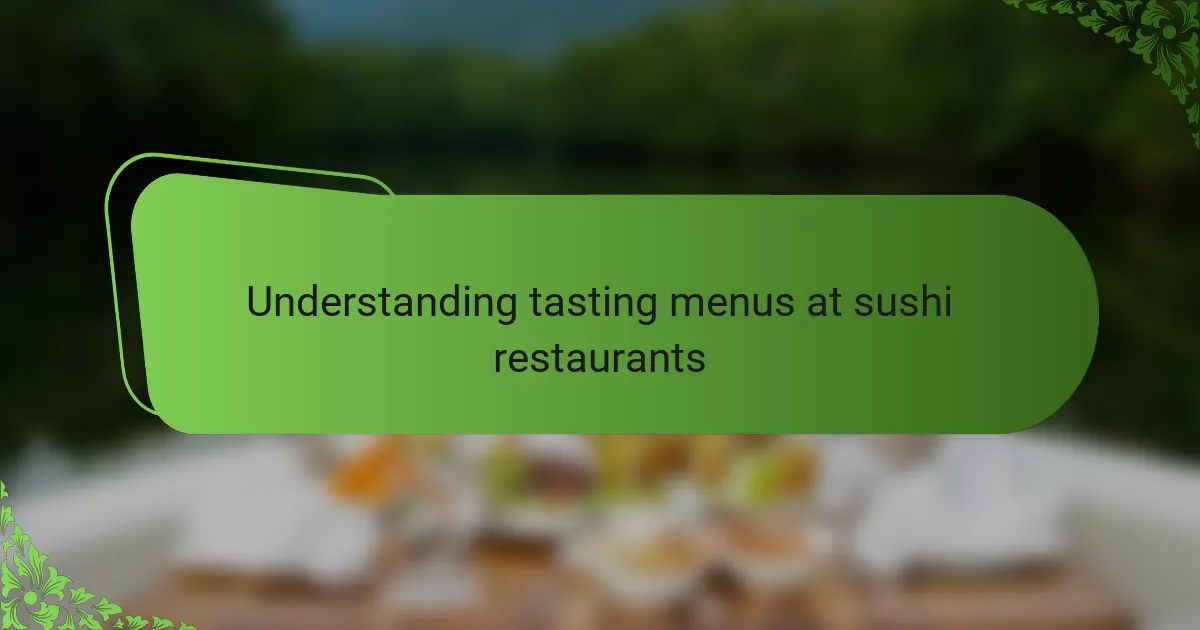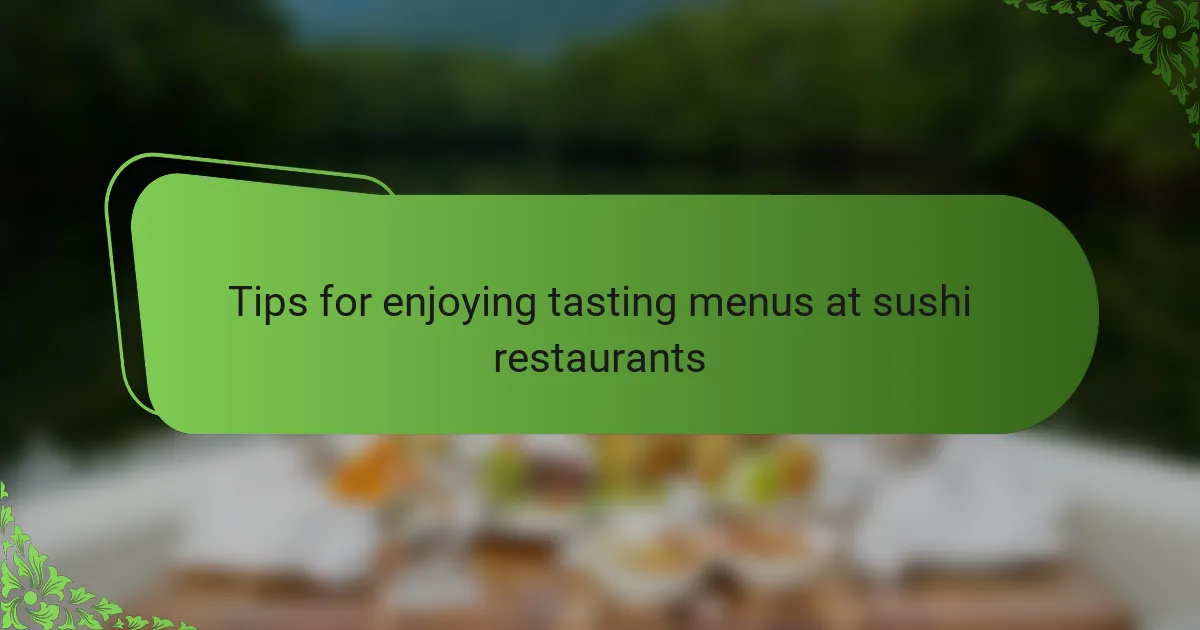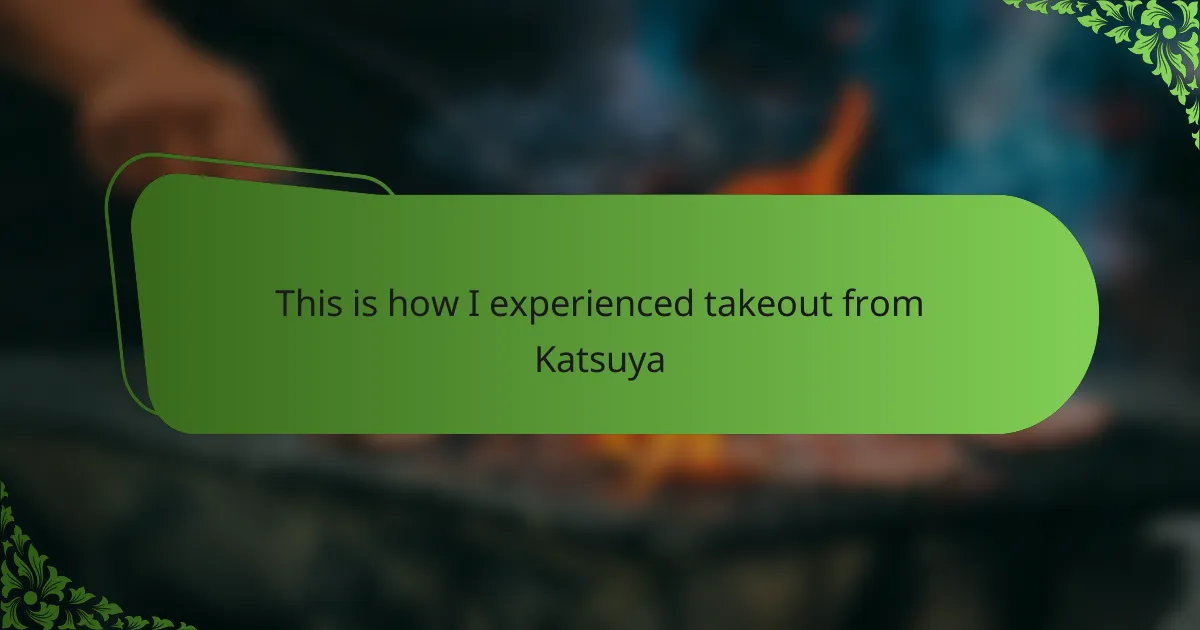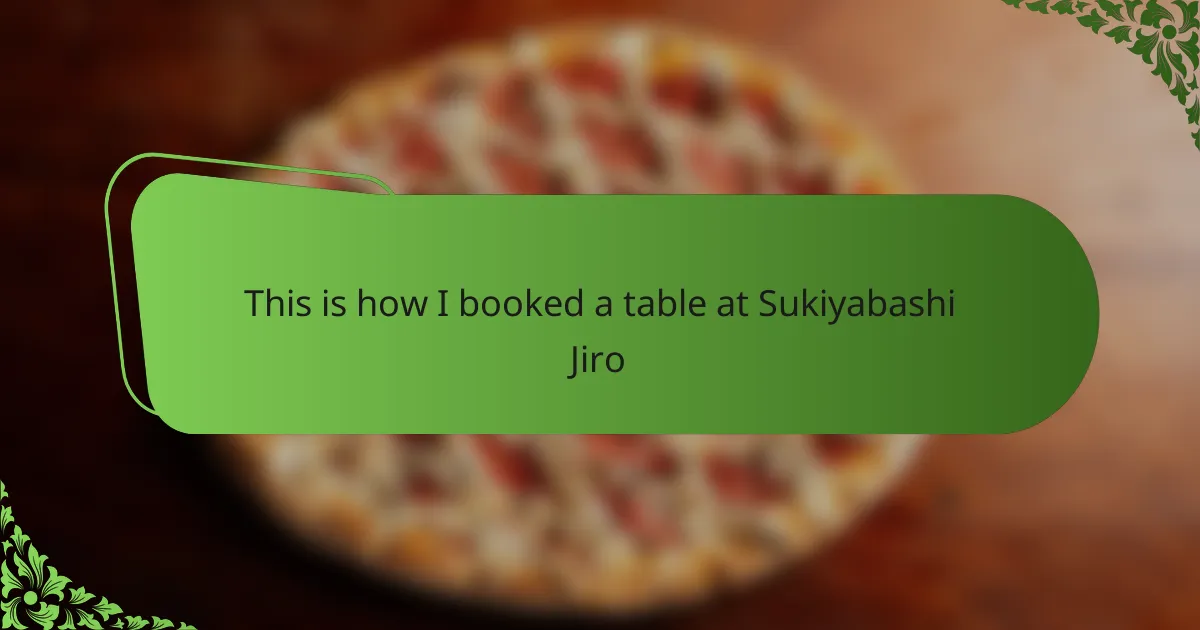Key takeaways
- Tasting menus at sushi restaurants offer a curated experience, inviting diners to trust the chef’s vision while savoring a journey of flavors and textures.
- The balance between tradition and innovation in the Chef’s Table tasting menu enhances the overall dining experience, with beautiful presentations and seasonal ingredients adding depth to the meal.
- Unlike a la carte options, tasting menus create a sense of adventure, allowing diners to explore new flavors and culinary creativity that they might have otherwise missed.
- To fully enjoy tasting menus, arrive with an appetite, pace yourself, and remain open to surprises to enhance the overall culinary experience.

Understanding tasting menus at sushi restaurants
Tasting menus at sushi restaurants aren’t just about eating; they’re a curated journey through flavors and textures. I remember my first experience — each piece of sushi felt like a story, carefully crafted to highlight the chef’s skill and the fish’s freshness. Have you ever paused to think about how each bite builds anticipation for the next?
What fascinates me most is how tasting menus transform dining into an immersive experience. Instead of ordering a la carte, you surrender to the chef’s vision, trusting their expertise to guide your palate through surprise and delight. It’s like letting someone else paint a masterpiece directly on your taste buds.
The pacing is another subtle art in itself. The courses unfold deliberately, never rushed, allowing time to appreciate the evolving flavors. This thoughtful progression makes the meal memorable, almost meditative, and it’s something I always look forward to during my visits.

Key features of Chef’s Table tasting menu
One of the standout features of the Chef’s Table tasting menu is its seamless balance between innovation and tradition. Each course surprised me with creative twists on classic sushi, yet it never lost that authentic touch that makes sushi so comforting. Have you ever tasted something familiar but entirely fresh at the same time? That’s exactly the feeling I got here.
The presentation is another element that truly impressed me. Every dish was a visual delight, almost too beautiful to eat—though I never hesitated for long. This careful attention to detail made the experience feel intimate, like the chef was sharing a personal story through each plate.
What I appreciate most is how the menu adapts to the seasons. Knowing that the ingredients are thoughtfully chosen based on availability adds a sense of connection to nature and place. It made me realize how much thought goes into crafting not just a meal, but a meaningful culinary narrative.

Comparing tasting menus with a la carte options
When I compare tasting menus to a la carte options, what stands out immediately is the sense of adventure versus control. With a la carte, you get to pick exactly what you want—you know what’s coming, and that’s comforting. But tasting menus invite you to let go, to trust the chef’s story unfolding one bite at a time. Have you ever tried surrendering like that and found it surprisingly freeing?
On the other hand, ordering a la carte lets you customize your experience entirely. I remember one visit when I craved extra nigiri and could tailor my meal to exactly satisfy that craving. The tasting menu, while thoughtfully varied, doesn’t offer that kind of flexibility; it’s more about the journey the chef designs, not the one you plot.
Yet, what I find fascinating is how tasting menus can introduce you to new flavors you might never pick on your own—imagine discovering a sashimi cut you didn’t even know existed or a subtle sauce that dances on your tongue. In contrast, a la carte feels safe and familiar, but sometimes I wonder if sticking to it limits the full spectrum of what a sushi chef can offer. Have you noticed that too?

Evaluating taste and presentation at Chef’s Table
Evaluating the taste at Chef’s Table feels like decoding a culinary poem. Each bite revealed layers of flavor that were both bold and delicate—like the way a perfectly aged soy sauce deepened the umami without overpowering the fresh fish. Have you ever had a dish where every ingredient feels intentionally placed, creating harmony rather than chaos? That’s what made this tasting menu stand out to me.
The presentation at Chef’s Table was nothing short of artistry. One course arrived looking like a tiny, edible landscape—colors and textures arranged with such care it felt almost meditative to gaze at before tasting. I found myself savoring the moment, appreciating not just the flavor but the visual story being told. Doesn’t a beautifully plated dish heighten your anticipation for what’s next?
What really struck me was how the balance between taste and presentation mirrored the chef’s philosophy—a marriage of respect for tradition and flair for innovation. It reminded me of those moments when you realize food has the power to connect you deeply to culture and creativity all at once. Do you think presentation can change how we perceive taste? For me, it absolutely does.

Personal experience with Chef’s Table tasting menu
Sitting at the Chef’s Table, I felt an immediate sense of intimacy with the meal—it wasn’t just dining, it was being part of something unfolding right before me. Each course felt like a personal message from the chef, carefully timed and thoughtfully composed. Have you ever had a meal where you actually look forward to what’s coming next, almost like waiting for the next chapter in a good book?
One moment that sticks with me was when a seemingly simple piece of sushi revealed unexpected complexity—subtle hints of yuzu and a delicate crunch that caught me off guard in the best way. That surprise sparked a real emotional connection to the food, making me appreciate how much craftsmanship goes into each bite. It made me wonder: how often do we rush through meals without stopping to savor these small but impactful details?
What I love most about this tasting experience is how it transformed time itself. The pacing allowed me to slow down, to engage my senses fully rather than just eat to fill up. It felt almost meditative, and I left with a deeper appreciation for the artistry behind sushi. Have you ever had a meal that changed the way you think about eating? This one certainly did for me.

Tips for enjoying tasting menus at sushi restaurants
One tip I always keep in mind is to arrive hungry but not starving. If you eat too much beforehand, you might miss the delicate flavors and textures that the chef carefully layers throughout the tasting. Have you ever found yourself too full halfway through a tasting menu? It’s such a shame because you really want to savor every bite from start to finish.
I also recommend pacing yourself with each course instead of rushing through them. Taking moments to appreciate the presentation and let the flavors linger helps the experience feel more immersive. When I slow down, I notice details I might otherwise overlook—like a subtle brush of sauce or the way the rice complements the fish. Don’t you think those little moments make sushi tasting menus truly special?
Lastly, being open to surprises makes all the difference. Trusting the chef’s choices can introduce you to new ingredients or flavor combinations you wouldn’t have picked on your own. I remember once trying a piece with an unusual topping, and it completely shifted how I think about sushi. Have you ever given a dish a chance and been pleasantly surprised? That willingness can turn a meal into a memorable culinary adventure.

Final thoughts on Chef’s Table tasting menus
Reflecting on my experiences with Chef’s Table tasting menus, what stays with me most is that feeling of complete immersion. It’s not just about the food; it’s about the story the chef is telling through each carefully crafted course. Have you ever felt that moment where every bite feels like a conversation between you and the chef? That’s the magic I always hope to find here.
I also appreciate how these tasting menus turn dining into an occasion for patience and presence. Slowing down to savor each flavor, each texture, changes how you connect with your meal—and with the chef’s artistry. Isn’t it fascinating how a well-paced menu can make time seem to stretch, letting you live fully in the moment?
At the end of the day, Chef’s Table tasting menus challenge you to trust the process, to embrace the unexpected. It’s a unique kind of adventure that rewards openness and curiosity in the most delicious ways. Have you ever walked away from a meal feeling not just satisfied, but touched? That’s exactly how these menus make me feel every time.



